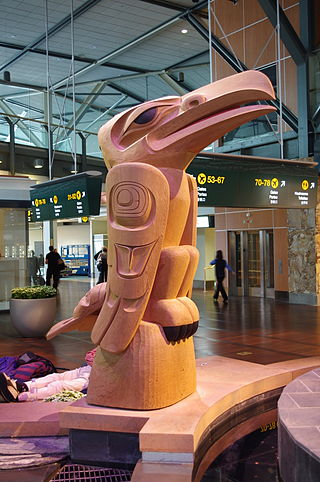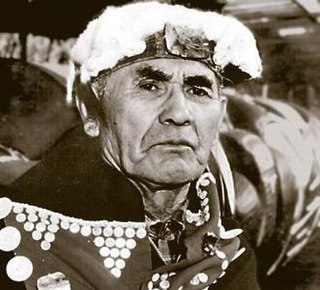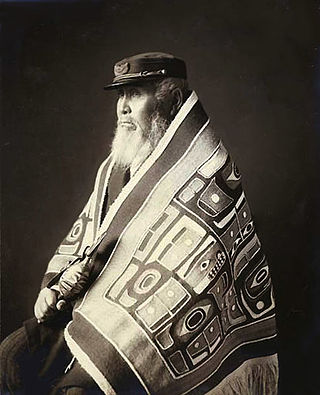Related Research Articles

Totem poles are monumental carvings found in western Canada and the northwestern United States. They are a type of Northwest Coast art, consisting of poles, posts or pillars, carved with symbols or figures. They are usually made from large trees, mostly western red cedar, by First Nations and Indigenous peoples of the Pacific Northwest Coast including northern Northwest Coast Haida, Tlingit, and Tsimshian communities in Southeast Alaska and British Columbia, Kwakwaka'wakw and Nuu-chah-nulth communities in southern British Columbia, and the Coast Salish communities in Washington and British Columbia.

A potlatch is a gift-giving feast practiced by Indigenous peoples of the Pacific Northwest Coast of Canada and the United States, among whom it is traditionally the primary governmental institution, legislative body, and economic system. This includes the Heiltsuk, Haida, Nuxalk, Tlingit, Makah, Tsimshian, Nuu-chah-nulth, Kwakwaka'wakw, and Coast Salish cultures. Potlatches are also a common feature of the peoples of the Interior and of the Subarctic adjoining the Northwest Coast, although mostly without the elaborate ritual and gift-giving economy of the coastal peoples.

The Kwakwa̱ka̱ʼwakw, also known as the Kwakiutl, are one of the indigenous peoples of the Pacific Northwest Coast. Their current population, according to a 2016 census, is 3,665. Most live in their traditional territory on northern Vancouver Island, nearby smaller islands including the Discovery Islands, and the adjacent British Columbia mainland. Some also live outside their homelands in urban areas such as Victoria and Vancouver. They are politically organized into 13 band governments.

Arthur Wellington Clah (1831–1916) was a Canadian First Nations employee of the Hudson's Bay Company at Lax Kw'alaams, B.C., known for having written extensive journals detailing his life and that of others in the settlement in the late 19th century. He was an hereditary chief in the Tsimshian nation, an anthropological informant, and a Methodist missionary.

Dempsey Bob, is a Northwest Coast woodcarver and sculptor from British Columbia, Canada, who is of Tahltan and Tlingit First Nations descent. He was born in the Tahltan village of Telegraph Creek on the Stikine River in northwestern B.C., and is of the Wolf clan.
Freda Diesing was a Haida woman of the Sadsugohilanes Clan, one of very few female carvers of Northwest Coast totem poles and a member of the Council of the Haida Nation of British Columbia, Canada. Her Haida name is Skil Kew Wat, meaning "magical little woman."

Northwest Coast art is the term commonly applied to a style of art created primarily by artists from Tlingit, Haida, Heiltsuk, Nuxalk, Tsimshian, Kwakwaka'wakw, Nuu-chah-nulth and other First Nations and Native American tribes of the Northwest Coast of North America, from pre-European-contact times up to the present.

Chief Mungo Martin or Nakapenkem, Datsa, was an important figure in Northwest Coast style art, specifically that of the Kwakwaka'wakw Aboriginal people who live in the area of British Columbia and Vancouver Island. He was a major contributor to Kwakwaka'wakw art, especially in the realm of wood sculpture and painting. He was also known as a singer and songwriter.

George Hunt (Tlingit) was a Canadian and a consultant to the American anthropologist Franz Boas; through his contributions, he is considered a linguist and ethnologist in his own right. He was Tlingit-English by birth and learned both those languages. Growing up with his parents at Fort Rupert, British Columbia in Kwakwaka'wakw territory, he learned their language and culture as well. Through marriage and adoption he became an expert on the traditions of the Kwakwaka'wakw of coastal British Columbia.
Calvin Hunt is a Canadian First Nations artist from Fort Rupert, British Columbia. The Kwakiutl are part of the larger nation Kwakwaka'wakw.

The Indigenous peoples of the Pacific Northwest Coast are composed of many nations and tribal affiliations, each with distinctive cultural and political identities. They share certain beliefs, traditions and practices, such as the centrality of salmon as a resource and spiritual symbol, and many cultivation and subsistence practices. The term Northwest Coast or North West Coast is used in anthropology to refer to the groups of Indigenous people residing along the coast of what is now called British Columbia, Washington State, parts of Alaska, Oregon, and Northern California. The term Pacific Northwest is largely used in the American context.

Ellen Neel (1916–1966) was a Kwakwakaʼwakw artist woodcarver and is the first woman known to have professionally carved totem poles. She came from Alert Bay, British Columbia, and her work is in public collections throughout the world.

A transformation mask, also known as an opening mask, is a type of mask used by indigenous people of the Northwest Coast of North America and Alaska in ritual dances. These masks usually depict an outer, animal visage, which the performer can open by pulling a string to reveal an inner human face carved in wood to symbolize the wearer moving from the natural world to a supernatural realm. Northwest coast peoples generally use them in potlatches to illustrate myths, while they are used by Alaska natives for shamanic rituals.

Kwakwaka'wakw art describes the art of the Kwakwaka'wakw peoples of British Columbia. It encompasses a wide variety of woodcarving, sculpture, painting, weaving and dance. Kwakwaka'wakw arts are exemplified in totem poles, masks, wooden carvings, jewelry and woven blankets. Visual arts are defined by simplicity, realism, and artistic emphasis. Dances are observed in the many rituals and ceremonies in Kwakwaka'wakw culture. Much of what is known about Kwakwaka'wakw art comes from oral history, archeological finds in the 19th century, inherited objects, and devoted artists educated in Kwakwaka'wakw traditions.
The following is an alphabetical list of topics related to Indigenous peoples in Canada, comprising the First Nations, Inuit and Métis peoples.
The North America Outgames were a multi-sport event held every three years by the Gay and Lesbian International Sport Association for LGBT athletes in North America. They were a regional derivation of the World Outgames, which is also held by GLISA, and they are held on different years than the World Outgames. GLISA was dissolved after the cancellation of the 2017 World Outgames IV.

Primrose Adams was a Canadian First Nations artist and member of the Raven Clan from the Haida nation. She wove hats and baskets in the Haida method and is most notable for her spruce root basketry, which involves working in the traditional manner of collecting and dyeing her own spruce root. Adams died in January 2020.

Beau Dick was a Kwakwaka'wakw Northwest Coast artist and Chief who lived and worked in Alert Bay, British Columbia, Canada. He was a contemporary artist, activist and hereditary Chief from the Namgis First Nation. Dick was an artist with an extensive national and international exhibition history.

Sonny Assu is a Ligwilda'xw Kwakwaka'wakw contemporary artist. Assu's paintings, sculptures, prints, installations, and interventions are all infused with his wry humour which is a tool to open the conversation around his themes of predilections: consumerism, colonization and imperialism.
Gloria Cranmer Webster was a Canadian First Nations activist, museum curator and writer of Kwakwaka'wakw descent.
References
- ↑ "Corrine Hunt / Alcheringa Gallery - Contemporary Aboriginal Art". www.alcheringa-gallery.com. Retrieved 2017-08-08.
- 1 2 Tepper, Leslie (2014). The Grand Hall: First Peoples of Canada's Northwest Coast. Library and Archives Canada. p. 80. ISBN 9780660202792.
- 1 2 3 Filice, Michelle. "Corrine Hunt". The Canadian Encyclopedia . Retrieved 2017-08-08.
- 1 2 "Corrine Hunt – Lattimer Gallery". www.lattimergallery.com. Retrieved 2017-08-08.
- ↑ "Commissions - Indian & Northern Affairs Canada Lobby - Sabina Hill". Sabina Hill. Retrieved 2017-08-08.
- ↑ Smith, ,Ian. "Gallery: Olympic medals through the years". www.vancouversun.com. Retrieved 2017-08-08.
{{cite news}}: CS1 maint: multiple names: authors list (link) - ↑ "2010 Olympic medal design unveiled". CBC News . Retrieved 2017-08-08.
- ↑ Smith, ,Ian. "Gallery: Olympic medals through the years". www.vancouversun.com. Retrieved 2017-08-08.
{{cite news}}: CS1 maint: multiple names: authors list (link) - ↑ "Outgames' medals created by Olympic co-designer". Gay Vancouver. Archived from the original on 2018-01-19. Retrieved 2017-08-08.
- ↑ "Claudia Alan Inc". www.claudiaalan.com. Retrieved 2017-08-08.
- ↑ "Manitobah Mukluks". Manitobah Mukluks. Retrieved 2017-08-08.
- ↑ Dimoff, Anna (February 27, 2018). "Meet the B.C. First Nations artist behind Canada's Olympic snowboard team's look". CBC.ca.
- ↑ "Staatliche Kunstsammlungen Dresden - The Great Potlatch". www.skd.museum. Archived from the original on 2015-10-13. Retrieved 2017-08-08.
- ↑ "Indspire | Corrine Hunt". indspire.ca. Retrieved 2017-08-08.
- Travis (1946) "Reminiscences of Fort Rupert, Kwakiutls Fort Rupert" The Beaver, Winnipeg, Dec 1946, page 651-657